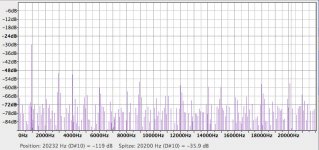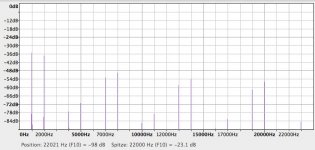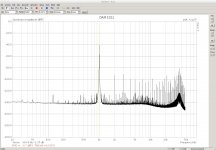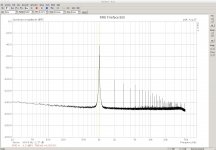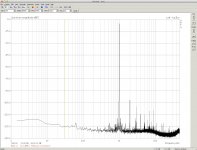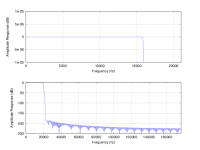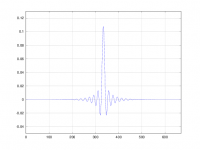13k5Hz-50Y here.
But seriously this is something I like to pursue if I get the hang of this. Why fight what’s been considered impossible for the last decay if I can’t hear it anyway?
Thanks for your feedback Paul. As always very informative.
And I Just realized that pos is the developer of rePhrase. Great work pos! That multilayered EQ is a wonderful idea.
But seriously this is something I like to pursue if I get the hang of this. Why fight what’s been considered impossible for the last decay if I can’t hear it anyway?
An externally hosted image should be here but it was not working when we last tested it.
Thanks for your feedback Paul. As always very informative.
And I Just realized that pos is the developer of rePhrase. Great work pos! That multilayered EQ is a wonderful idea.
As an illustration of the effect of the aliases of the harmonics I did in Audacity a 1kHz, 32-bit sawtooth (lots of harmonics) and computed its spectrum. Once for fs 44.1kHz and once for 48kHz . You may guess which is which:
Attachments
Yes:I know what is going on!
1088 Hz tone is same in 48, 96, 192 and 384. than 1000 Hz tone in 44, 88, 172, 352.
Why? That does not happen with other DAC. Maybe yes and not see because noise is -135 dB or more. In any case with last filters problems are lessened, perhaps not saturate or less level.
I leave this and focus on the phase of the filters.
Thank you very much.
Just really curious...
Was it:
This is all done Macbook Pro -> USB -> Amanero -> DAM unbuffered outputs -> TC Electronics Konnet 8 (with Welborne Labs Linear PSU) -> Firewire RX (on MbP).
//
Buffered XLR.
Yes:
1088 Hz tone is same in 48, 96, 192 and 384. than 1000 Hz tone in 44, 88, 172, 352.
Why? That does not happen with other DAC. Maybe yes and not see because noise is -135 dB or more. In any case with last filters problems are lessened, perhaps not saturate or less level.
I leave this and focus on the phase of the filters.
Thank you very much.
I think it is a math or clock division issue. In a fit of madness I tried shifting the frequency away from 1000kHz in 1hz steps. It seemed to me that odd frequencies were cleaner than even but there was a variability in degree.
FWIW Brown Burr used 997Hz for the PCM63 performance figures and it gives better results on that chip than 1000Hz.
Excellent insight.
Have you thought of making a filter for old people? We can't hear past 16K. This gives you 4K more of transition band
TBH, no. I'm 48 and I can hear probably 16kHz with any real certainty but if I make filters that are rolling off at that point they sound dull/dead in comparison with ones that roll off higher.
13k5Hz-50Y here.
But seriously this is something I like to pursue if I get the hang of this. Why fight what’s been considered impossible for the last decay if I can’t hear it anyway?
An externally hosted image should be here but it was not working when we last tested it.
Thanks for your feedback Paul. As always very informative.
And I Just realized that pos is the developer of rePhrase. Great work pos! That multilayered EQ is a wonderful idea.
Yoiks!!! That filter is -30dB at 20kHz.
Are you listening to these experiments?
The stacked filters work pretty well but they can be hard to juggle as they work in unpredictable ways once you start trying to force steep filters.
Yes:
1088 Hz tone is same in 48, 96, 192 and 384. than 1000 Hz tone in 44, 88, 172, 352.
Why? That does not happen with other DAC. Maybe yes and not see because noise is -135 dB or more. In any case with last filters problems are lessened, perhaps not saturate or less level.
I leave this and focus on the phase of the filters.
Thank you very much.
If you reduce the bit resolution dithering and no dithering has an effect in that direction.
In the DAM I see two places where the bit resolution is reduced: at the output of the accumulators and when passing the signal to the DAC ladder. On the other hand that is on such a high bit resolution (at least 28 bit) that I do not believe that this could be the explanation , ... unless Soren made an implementation error in the FPGA
Last edited:
Ditto impressions. I am 41TBH, no. I'm 48 and I can hear probably 16kHz with any real certainty but if I make filters that are rolling off at that point they sound dull/dead in comparison with ones that roll off higher.
Ayre "listen" filter (and PONO) is approx -3db down at 20khz if my memory is right?
Last edited:
As an illustration of the effect of the aliases of the harmonics I did in Audacity a 1kHz, 32-bit sawtooth (lots of harmonics) and computed its spectrum. Once for fs 44.1kHz and once for 48kHz . You may guess which is which:
I did try a slow swept sine at one point, and it did seem from looking at the "hump" around 40kHz that harmonics were basically moving smoothly across the band I was looking at but were riding up over the "hump". At certain points the harmonics were on each side of the "hump" and at others were on it's peak - which gave a difference of around 18dB in level of the harmonic.
Last edited:
Yoiks!!! That filter is -30dB at 20kHz.
Are you listening to these experiments?
The stacked filters work pretty well but they can be hard to juggle as they work in unpredictable ways once you start trying to force steep filters.

I'll play around until I get something with 0dB at 16k and minimal ringing. Then try to “measure” before I torture my gear and ears. Still long way to go.
I did try a slow swept sine at one point, and it did seem from looking at the "hump" around 40kHz that harmonics were basically moving smoothly across the band I was looking at but were riding up over the "hump". At certain points the harmonics were on each side of the "hump" and at others were on it's peak - which gave a difference of around 18dB in level of the harmonic. The "hump" disappears with a single filter co-efficent (0.12499999 and gain of x8), which I believe indicates that it isn't due to imaging of the test tone.
I totaly agree with that. My argument was only for indikating that is normal that a 1kHz test tone looks potetnially "cleaner" with fs 48kHz than 44.1kHz.
The "hump" must have an other explanation. What filters did you use?
Paul, did you mention filters used on those measurements?
A variety of filter combinations. There is no really significant difference. Even TNT's "one filter to rule them all" (MB2) didn't make any difference.
The only filter one that appeared to have any effect on the 40kHz trash was the SuperAPO filter which attenuates at something like 21kHz. It could be the 40kHz garbage is a level dependent artefact of the Konnket 8, although it is not present with the NOS filter.
I'll try to do some checks with my D1 today and see if the 40kHz junk is still present.
I'll check if a filter that cuts off well under 22kHz with heavy stop band attenuation makes any difference.
Last edited:
I just remembered I made some measurements long ago, 1kHz test tone at fs=96kHz with the stock filters and had also an hump around 40kHz.
The measurements were made with a RME800 and ARTA, I did not exactly calibrated ARTA, so the dBs are not necessarily correct.
I measured the DAM, the RME and the AD1955 eval-board. Only the DAM had that hump.
So it seems not to be a measurement issue.
(images DAM, RME, AD1955)
The measurements were made with a RME800 and ARTA, I did not exactly calibrated ARTA, so the dBs are not necessarily correct.
I measured the DAM, the RME and the AD1955 eval-board. Only the DAM had that hump.
So it seems not to be a measurement issue.
(images DAM, RME, AD1955)
Attachments
Damn Those Young WhipperSnappers....
For those curmudgeons who want to wallow in their dotage (and failing hearing).
This has turned out somewhat like DEQ's "full steam ahead, and don't spare the high end" special.
DTYWS starts to roll-off at just under 16kHz, is down a comparatively restrained 22dB at 20kHz, is -130dB at 22kHz and bottoms out at -180dB at 22.4kHz.
Who cares if the young'ns think it sounds bad.
FWIW the passband response graph extents are +/-0.00001dB so don't be too alarmed at the precipitous drop in response.
For those curmudgeons who want to wallow in their dotage (and failing hearing).
This has turned out somewhat like DEQ's "full steam ahead, and don't spare the high end" special.
DTYWS starts to roll-off at just under 16kHz, is down a comparatively restrained 22dB at 20kHz, is -130dB at 22kHz and bottoms out at -180dB at 22.4kHz.
Who cares if the young'ns think it sounds bad.
FWIW the passband response graph extents are +/-0.00001dB so don't be too alarmed at the precipitous drop in response.
Attachments
Last edited:
Power on the RME a lot of time?
It is possible that the clock is hot enough to dismiss hump measures of RME and the AD1955 eval-board, if this measures are after DAM measure?
It is typical if it takes little time on.
As I said it is quite a while I did this, so with the details....
But the RME runs from morning to evening and surely was hot. The measurements were made "one after the other" so under similar conditions. The DAM and AD1955 got their digital signal over SPDIF-coax from the RME. The RME measurement was an analog loopback.
Last edited:
- Home
- Source & Line
- Digital Line Level
- Filter brewing for the Soekris R2R
